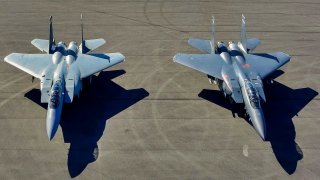How Can the F-15EX Fighter Be More Expensive Than the F-35?
The F-15EX, capable of carrying up to 30,000 pounds of munitions, is among the most heavily armed aircraft in the U.S. Air Force. However, its high cost, with a potential "flyaway cost" of $94 million per aircraft, has raised concerns.
Summary: The Polish Air Force is in discussions with Boeing to acquire nearly two dozen F-15EX Eagle II fighters, an advanced multirole strike aircraft. The F-15EX, capable of carrying up to 30,000 pounds of munitions, is among the most heavily armed aircraft in the U.S. Air Force. However, its high cost, with a potential "flyaway cost" of $94 million per aircraft, has raised concerns. Foreign military orders from countries like Indonesia and Israel could help lower costs, making the acquisition more appealing for the U.S. Air Force and taxpayers.

Boeing's F-15EX Fighter Is Pretty Expensive
Last week, it was reported that the Polish Air Force has been in discussions with aerospace giant Boeing regarding the potential acquisition of nearly two dozen F-15EX Eagle II fighters, the highly upgraded all-weather multirole strike aircraft derived from the McDonnell Douglas F-15E Strike Eagle.
As previously reported by Stavros Atlamazoglou for The National Interest, the 4++ generation fighter was developed to carry up to 30,000 pounds of munitions, "making it the most heavily armed aircraft" in service with the United States Air Force. However, it has also been reported that the F-15EX Eagle II could be among the most expensive fighters currently being acquired by the air service.
Warsaw's interest in the Eagle II – part of a much broader modernization of Poland's combat air fleet – could be welcome news to Washington. Not just because – as Atlamazoglou further noted the Eagle II can be employed in both an air superiority and ground support role and would be well-suited to being employed on NATO's eastern flank, but because the more aircraft that are built, the lower the cost could be.
The F-15EX is Now Pricier Than the F-35
Boeing has long touted the F-15EX to be a "do-it-all" fighter, while the aerospace firm has also claimed it would be easier to build and quicker to put into service, while it will also result in a platform that can be maintained more cost-effectively when compared to an equal number of F-35s. Boeing further has made the case that the F-15EX can enable rapid technology insertion that will ensure the platform's relevance for decades to come.
As this reporter noted last year, the Eagle II is equipped with an Open Mission Systems Architecture, which can deliver Advanced Battle Management Systems (ABMS) capabilities, allowing the F-15EX to operate independently while isolated but also to reconnect to the global cloud.
This technology will come with a substantial cost, however.
Last October, the DoD warned that the F-15EX could have a "flyaway cost" of as much as $94 million per aircraft, and that's only if the U.S. Air Force followed through on its plans to acquire 104 aircraft. If that number drops, the costs would go up. According to Air & Space Forces magazine, the air service had previously eyed purchasing as many as 200 Eagle IIs, only to reduce that number. The initial unit cost estimate for the multirole F-15EX had been $80 million – which even then wasn't exactly a bargain, as it was on par with the F-35.
Breaking Defense, citing an Air Force spokesperson, further noted that "the price for an F-15EX will start at 'approximately' $90 million for lot 2, rise to $97 million in lot 3 and then dip to $94 million in lot 4."
It is more than just the order being slashed. The flyaway cost values an aircraft's cost of production, as well as the production tools essential for building it, and that has increased due to inflation and continued supply chain woes. Boeing had backtracked on its estimates.

Officials with the aerospace firm have since vowed to bring the costs down, and it has suggested that foreign military orders will help control the cost of the F-15EX. Indonesia has joined Poland in eyeing the Eagle II, while Israel is on track to obtain 25 of the aircraft – which be designated the F-15IA in Israel Air Force (IAF) service – and could even double the order. That would be music to the ears of Boeing executives, and likely even better news for the U.S. Air Force and taxpayers alike as it could lower the F-15EX's costs.
Author Experience and Expertise: Peter Suciu
Peter Suciu is a Michigan-based writer. He has contributed to more than four dozen magazines, newspapers, and websites with over 3,200 published pieces over a twenty-year career in journalism. He regularly writes about military hardware, firearms history, cybersecurity, politics, and international affairs. Peter is also a Contributing Writer for Forbes and Clearance Jobs. You can follow him on Twitter: @PeterSuciu. You can email the author: [email protected].
All images are Creative Commons.


